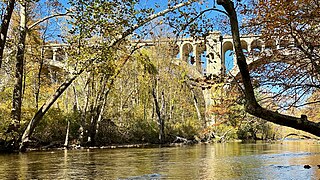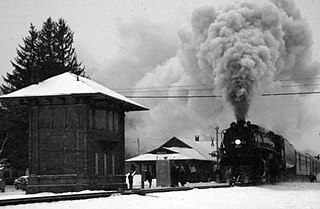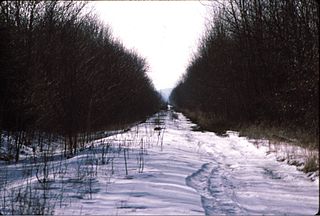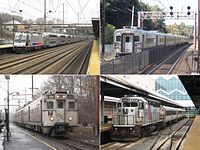
New Jersey Transit Corporation, branded as NJ Transit or NJTransit and often shortened to NJT, is a state-owned public transportation system that serves the U.S. state of New Jersey and portions of the states of New York and Pennsylvania. It operates bus, light rail, and commuter rail services throughout the state, connecting to major commercial and employment centers both within the state and in its two adjacent major cities, New York City and Philadelphia. In 2023, the system had a ridership of 209,259,800.

The Delaware, Lackawanna and Western Railroad, also known as the DL&W or Lackawanna Railroad, was a U.S. Class 1 railroad that connected Buffalo, New York, and Hoboken, New Jersey, and by ferry with New York City, a distance of 395 miles (636 km). The railroad was incorporated in Pennsylvania in 1853, and created primarily to provide a means of transport of anthracite coal from the Coal Region in Northeast Pennsylvania to large coal markets in New York City. The railroad gradually expanded both east and west, and eventually linked Buffalo with New York City.

The Erie Lackawanna Railway, known as the Erie Lackawanna Railroad until 1968, was formed from the 1960 merger of the Erie Railroad and the Delaware, Lackawanna & Western Railroad. The official motto of the line was "The Friendly Service Route".

The Morristown Line is an NJ Transit commuter rail line connecting Morris and Essex counties to New York City, via either New York Penn Station or Hoboken Terminal. Out of 60 inbound and 58 outbound daily weekday trains, 28 inbound and 26 outbound Midtown Direct trains use the Kearny Connection to Penn Station; the rest go to Hoboken. Passengers can transfer at Newark Broad Street or Summit to reach the other destination. On rail system maps the line is colored dark green, and its symbol is a drum, a reference to Morristown's history during the American Revolution.

The Lackawanna Cut-Off was a rail line built by the Delaware, Lackawanna and Western Railroad (DL&W). Constructed from 1908 to 1911, the line was part of a 396-mile (637 km) main line between Hoboken, New Jersey, and Buffalo, New York. It ran west for 28.45 miles (45.79 km) from Port Morris Junction in Port Morris, New Jersey, near the south end of Lake Hopatcong about 45 miles (72 km) west-northwest of New York City, to Slateford Junction in Slateford, Pennsylvania near the Delaware Water Gap.

Newark Broad Street station is a New Jersey Transit commuter rail and light rail station at 25 University Avenue in Newark, New Jersey. Built in 1903, the station's historic architecture includes an elegant clock tower and a brick and stone façade on the station's main building. In June 1984, the station was added to the National Register of Historic Places in recognition of its historical significance.

Lake Hopatcong is a commuter railroad station for New Jersey Transit. The station, located in the community of Landing in Roxbury Township, Morris County, New Jersey, United States, serves trains for the Montclair-Boonton Line and Morristown Line at peak hours and on holiday weekends. Service from Lake Hopatcong is provided to/from Hackettstown to New York Penn Station and Hoboken Terminal. The stop is located on the tracks below Landing Road next to the eponymous Lake Hopatcong. The station consists of one active platform with shelter, and an abandoned side platform. There is no accessibility for handicapped people.

The Pennsylvania Northeast Regional Railroad Authority (PNRRA) is a bi-county creation of both Lackawanna and Monroe counties to oversee the use of common rail freight lines in Northeastern Pennsylvania. The designated freight operator of the Pennsylvania Northeast Regional Rail Authority lines is the Delaware-Lackawanna Railroad and tourism operator is Steamtown National Historic Site.

The Paulinskill Viaduct, also known as the Hainesburg Viaduct, is a reinforced concrete railroad bridge that crosses the Paulins Kill in Knowlton Township, New Jersey. When completed in 1910, it was the largest reinforced concrete structure in the world.

The Delaware River Viaduct is a reinforced concrete railroad bridge across the Delaware River about two miles (3.2 km) south of the Delaware Water Gap that was built from 1908 to 1910 as part of the Lackawanna Cut-Off rail line. It is the sister to the line's larger Paulinskill Viaduct. The Delaware River Viaduct also crosses Interstate 80 on the east side of the river and Slateford Road and the Lackawanna Railroad's "Old Road" on the west (Pennsylvania) side. Abandoned in 1983, it is part of an Amtrak proposal to introduce passenger service between Scranton, Pennsylvania and New York City, a distance of 135 mi (217 km).

East Stroudsburg is an historic train station built by the Delaware, Lackawanna and Western Railroad in 1856. The station served as the local stop for both East Stroudsburg and Stroudsburg, Pennsylvania. The depot, recently known locally as the Dansbury Depot for the restaurant that used the building, is located on Crystal Street in East Stroudsburg. Service to East Stroudsburg ended on January 6, 1970, when the Erie Lackawanna Railway discontinued the Lake Cities. A proposal is currently in place to extend NJ Transit service to a rebuilt East Stroudsburg station. In spring 2021, Amtrak announced plans for potential New York–Scranton route. It is currently used by some of Steamtown National Historic Site's excursion trains.
Lackawanna Transit Center is the main bus station and a proposed train station in Scranton, Pennsylvania, operated by the County of Lackawanna Transit System (COLTS).

Tobyhanna station is a proposed NJ Transit commuter rail station that is located in Coolbaugh Township, Monroe County, Pennsylvania in the United States. The station forms part of a site owned by a number of public and private entities including the Pennsylvania Northeast Regional Railroad Authority.

Pocono Mountain is a proposed New Jersey Transit Rail Operations (NJT) station located in Coolbaugh Township, Monroe County, Pennsylvania and is part of a site that was formerly utilized as a summer camp. The proposed station site, which will include a 1,000-space surface parking lot, is located northwest of a multi-phased planned development for this area. Access will be from Pennsylvania Route 611 via Pocono Municipal Road/Mount Pocono Road and a local access road and the platform would be situated east of the track.
The North Jersey Rail Commuter Association is a not for profit railroad advocacy organization that was formed and incorporated in the United States in 1980. During its history, the organization and its members have been involved in the successful advocacy of a number of projects involving NJ Transit Rail Operations. NJRCA's headquarters are located in Knowlton Township, New Jersey.

Port Morris Junction is the railroad connection between NJ Transit's Montclair-Boonton Line and the Lackawanna Cut-Off. Opened in 1911 by the Lackawanna Railroad, it is in the Port Morris, New Jersey section of Roxbury Township, New Jersey, south of Lake Hopatcong.

Roseville Tunnel is a 1,024-foot (312 m) two-track railroad tunnel on the Lackawanna Cut-Off in Byram Township, Sussex County, New Jersey. The tunnel is on a straight section of railroad between mileposts 51.6 and 51.8 (83 km), about 6 miles (9.7 km) north by northwest of Port Morris Junction. Operated for freight and passenger service from 1911 to 1979, it is undergoing work intended to return it to passenger service by 2026.

Greendell is one of three original railway stations built by the Delaware, Lackawanna & Western Railroad (DL&W) along its Lackawanna Cut-Off line in northwestern New Jersey. The station, which still stands in Green Township at milepost 57.61 on the Cut-Off, began operations on December 23, 1911, one day before the line itself opened and the first revenue train arrived.

Andover is a planned New Jersey Transit passenger railroad station in Andover Township, in Sussex County, New Jersey, United States, providing service on its Lackawanna Cut-Off line. The line remains under construction. The station will be built at a site on Andover's Roseville Road, about 1.1 miles (1.8 km) from U.S. Route 206 and about 0.9 miles (1.4 km) from County Route 517. On the rail line, it will be located about 7.3 miles (11.7 km) west of Port Morris Junction.

Blairstown was one of the three original Delaware, Lackawanna and Western Railroad stations on the Lackawanna Cut-Off rail line in northwestern New Jersey. Built by contractor Hyde, McFarlan & Burke, the station opened in 1911. Most passenger trains, such as the Lackawanna Limited and, later, the Phoebe Snow, plus the Twilight/Pocono Express and the Westerner/New Yorker stopped at Blairstown, which also sold commuter tickets.



































